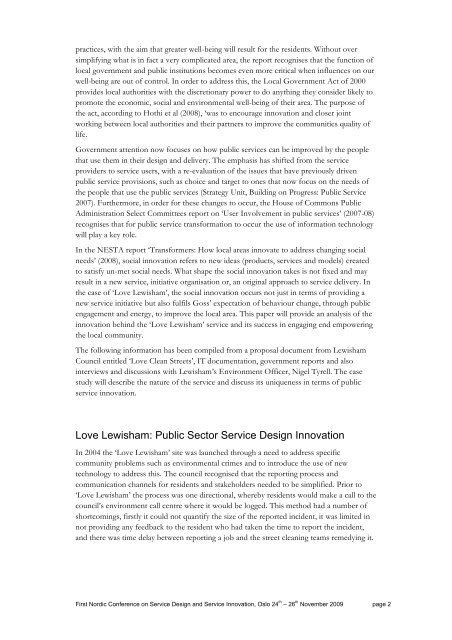improving stakeholder satisfaction in local government ... - ServDes.
improving stakeholder satisfaction in local government ... - ServDes.
improving stakeholder satisfaction in local government ... - ServDes.
Create successful ePaper yourself
Turn your PDF publications into a flip-book with our unique Google optimized e-Paper software.
practices, with the aim that greater well-be<strong>in</strong>g will result for the residents. Without oversimplify<strong>in</strong>g what is <strong>in</strong> fact a very complicated area, the report recognises that the function of<strong>local</strong> <strong>government</strong> and public <strong>in</strong>stitutions becomes even more critical when <strong>in</strong>fluences on ourwell-be<strong>in</strong>g are out of control. In order to address this, the Local Government Act of 2000provides <strong>local</strong> authorities with the discretionary power to do anyth<strong>in</strong>g they consider likely topromote the economic, social and environmental well-be<strong>in</strong>g of their area. The purpose ofthe act, accord<strong>in</strong>g to Hothi et al (2008), ‘was to encourage <strong>in</strong>novation and closer jo<strong>in</strong>twork<strong>in</strong>g between <strong>local</strong> authorities and their partners to improve the communities quality oflife.Government attention now focuses on how public services can be improved by the peoplethat use them <strong>in</strong> their design and delivery. The emphasis has shifted from the serviceproviders to service users, with a re-evaluation of the issues that have previously drivenpublic service provisions, such as choice and target to ones that now focus on the needs ofthe people that use the public services (Strategy Unit, Build<strong>in</strong>g on Progress: Public Service2007). Furthermore, <strong>in</strong> order for these changes to occur, the House of Commons PublicAdm<strong>in</strong>istration Select Committees report on ‘User Involvement <strong>in</strong> public services’ (2007-08)recognises that for public service transformation to occur the use of <strong>in</strong>formation technologywill play a key role.In the NESTA report ‘Transformers: How <strong>local</strong> areas <strong>in</strong>novate to address chang<strong>in</strong>g socialneeds’ (2008), social <strong>in</strong>novation refers to new ideas (products, services and models) createdto satisfy un-met social needs. What shape the social <strong>in</strong>novation takes is not fixed and mayresult <strong>in</strong> a new service, <strong>in</strong>itiative organisation or, an orig<strong>in</strong>al approach to service delivery. Inthe case of ‘Love Lewisham’, the social <strong>in</strong>novation occurs not just <strong>in</strong> terms of provid<strong>in</strong>g anew service <strong>in</strong>itiative but also fulfils Goss’ expectation of behaviour change, through publicengagement and energy, to improve the <strong>local</strong> area. This paper will provide an analysis of the<strong>in</strong>novation beh<strong>in</strong>d the ‘Love Lewisham’ service and its success <strong>in</strong> engag<strong>in</strong>g end empower<strong>in</strong>gthe <strong>local</strong> community.The follow<strong>in</strong>g <strong>in</strong>formation has been compiled from a proposal document from LewishamCouncil entitled ‘Love Clean Streets’, IT documentation, <strong>government</strong> reports and also<strong>in</strong>terviews and discussions with Lewisham’s Environment Officer, Nigel Tyrell. The casestudy will describe the nature of the service and discuss its uniqueness <strong>in</strong> terms of publicservice <strong>in</strong>novation.Love Lewisham: Public Sector Service Design InnovationIn 2004 the ‘Love Lewisham’ site was launched through a need to address specificcommunity problems such as environmental crimes and to <strong>in</strong>troduce the use of newtechnology to address this. The council recognised that the report<strong>in</strong>g process andcommunication channels for residents and <strong>stakeholder</strong>s needed to be simplified. Prior to‘Love Lewisham’ the process was one directional, whereby residents would make a call to thecouncil’s environment call centre where it would be logged. This method had a number ofshortcom<strong>in</strong>gs, firstly it could not quantify the size of the reported <strong>in</strong>cident, it was limited <strong>in</strong>not provid<strong>in</strong>g any feedback to the resident who had taken the time to report the <strong>in</strong>cident,and there was time delay between report<strong>in</strong>g a job and the street clean<strong>in</strong>g teams remedy<strong>in</strong>g it.First Nordic Conference on Service Design and Service Innovation, Oslo 24 th – 26 th November 2009 page 2
















